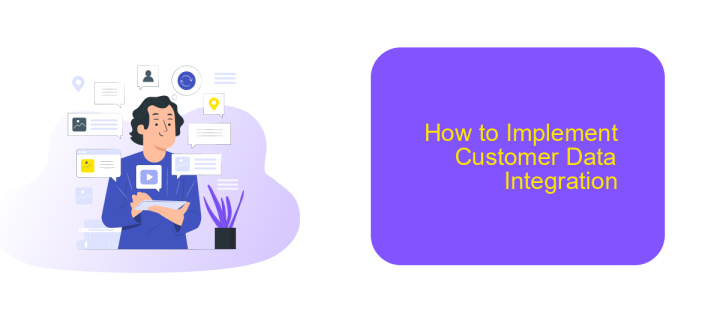What is Customer Data Integration
Customer Data Integration (CDI) is the process of combining data about customers from various sources into a unified, comprehensive view. This integration allows businesses to gain valuable insights, improve customer relationships, and enhance decision-making. By centralizing customer information, companies can ensure data accuracy, streamline operations, and deliver personalized experiences, ultimately driving growth and customer satisfaction.
What is Customer Data Integration?
Customer Data Integration (CDI) is the process of combining customer information from various sources into a unified, comprehensive view. This allows businesses to gain a holistic understanding of their customers, leading to better decision-making and improved customer experiences. By integrating data, companies can ensure consistency and accuracy across different departments and channels.
- Improved data accuracy and consistency
- Enhanced customer insights and analytics
- Streamlined operations and reduced redundancies
- Better customer segmentation and targeting
- Increased customer satisfaction and loyalty
Implementing CDI can be complex, but tools like ApiX-Drive simplify the process by enabling seamless integration of various data sources. ApiX-Drive provides a user-friendly platform that connects different applications and automates data synchronization, ensuring that customer information is always up-to-date and accessible. This not only saves time but also minimizes errors, allowing businesses to focus on delivering exceptional customer experiences.
Benefits of Customer Data Integration

Customer Data Integration (CDI) offers numerous benefits that can significantly enhance business operations. By consolidating data from various sources into a unified view, businesses gain a comprehensive understanding of their customers. This holistic view enables more accurate customer segmentation, personalized marketing efforts, and improved customer service. Additionally, CDI reduces data redundancy and inconsistency, ensuring that all departments have access to the same accurate information, which leads to better decision-making and increased operational efficiency.
Implementing CDI can be streamlined with tools like ApiX-Drive, which facilitates seamless integration between different systems and applications. ApiX-Drive automates data transfer processes, saving time and reducing the risk of human error. This not only enhances data accuracy but also allows businesses to quickly adapt to changing market conditions by easily integrating new data sources. Ultimately, the benefits of CDI, supported by robust integration tools, translate to a more agile and customer-centric business model, driving growth and competitive advantage.
Challenges of Customer Data Integration

Integrating customer data can be a complex process fraught with numerous challenges. Organizations often struggle with data silos, where customer information is scattered across multiple systems, making it difficult to obtain a unified view. Additionally, data quality issues such as duplicates, inaccuracies, and inconsistencies can significantly hinder the integration process.
- Data Silos: Fragmented data across various platforms can prevent a holistic view of customer information.
- Data Quality: Inaccurate or inconsistent data can complicate integration efforts.
- Scalability: Integrating data from an increasing number of sources can be challenging as businesses grow.
- Compliance: Ensuring that data integration processes comply with regulations like GDPR can be complex.
- Technical Complexity: The technical aspects of integrating various systems can be daunting and require specialized knowledge.
To mitigate these challenges, leveraging integration platforms such as ApiX-Drive can be highly beneficial. ApiX-Drive simplifies the integration process by connecting various data sources and ensuring data consistency and accuracy. This allows organizations to achieve a seamless and scalable customer data integration, ultimately enhancing decision-making and customer experience.
How to Implement Customer Data Integration

Implementing Customer Data Integration (CDI) begins with a thorough assessment of your current data sources and systems. Identify where customer data is stored, such as CRM systems, marketing platforms, and e-commerce databases. Understanding the data landscape is crucial to ensure a seamless integration process.
Once you have a clear understanding of your data sources, the next step is to choose the right tools and technologies for integration. Platforms like ApiX-Drive can simplify this process by providing pre-built connectors and automation capabilities. These tools can help you integrate data from various sources without extensive coding or technical expertise.
- Assess current data sources and systems
- Choose the right integration tools and technologies
- Implement data mapping and transformation
- Ensure data quality and consistency
- Monitor and maintain the integration process
After selecting the appropriate tools, it's essential to map and transform the data to ensure consistency across all systems. Regular monitoring and maintenance are also critical to address any issues that arise and to keep the integration process running smoothly. By following these steps, you can effectively implement CDI and leverage accurate customer data for better decision-making.
- Automate the work of an online store or landing
- Empower through integration
- Don't spend money on programmers and integrators
- Save time by automating routine tasks
Tips for Successful Customer Data Integration
Successful customer data integration begins with a clear strategy. Define your objectives and identify the data sources you need to integrate. Ensure data consistency by standardizing formats and eliminating duplicates. Regularly update and cleanse your data to maintain accuracy. Establish a governance framework to manage data quality and compliance, assigning roles and responsibilities within your team.
Utilizing the right tools can significantly streamline the integration process. Consider using services like ApiX-Drive, which offer automated data synchronization between various platforms, reducing manual effort and minimizing errors. ApiX-Drive provides a user-friendly interface and supports a wide range of applications, making it easier to connect disparate data sources. Additionally, continuously monitor the integration process and gather feedback to make necessary adjustments, ensuring the system evolves with your business needs.
FAQ
What is Customer Data Integration (CDI)?
Why is Customer Data Integration important?
What are the challenges of Customer Data Integration?
How can businesses implement Customer Data Integration?
What tools can help with Customer Data Integration?
Time is the most valuable resource in today's business realities. By eliminating the routine from work processes, you will get more opportunities to implement the most daring plans and ideas. Choose – you can continue to waste time, money and nerves on inefficient solutions, or you can use ApiX-Drive, automating work processes and achieving results with minimal investment of money, effort and human resources.


